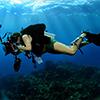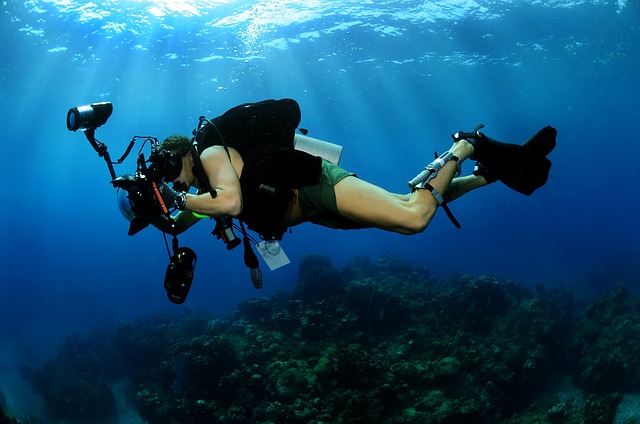

Underwater photography is both an educational tool and an exciting hobby. Capturing photographs of sea life gives us a glimpse of a world we don't often get to see. It also helps scientists study these organisms and how they live in their watery
environment. The equipment needed to take pictures in the water can vary depending on the photographer's needs and conditions such as the depth of the water and how much light is penetrating it. Swimmers can use simple waterproof digital cameras
to take pictures close to the surface, while scuba divers and scientists go to deeper areas with special watertight cameras and light sources such as this underwater video camera.
For casual underwater photographers, a waterproof digital camera or even a water-resistant smartphone may suffice. Some of the top-brand digital cameras have an underwater mode built into the camera. For digital cameras that aren't waterproof,
you can buy watertight housings made specifically for your camera model. If you decide to go this route, make sure to buy the right one for your camera, as it will be engineered to be waterproof while still allowing you to access the buttons
to adjust settings while you use it. Of course, you can also purchase a waterproof disposable camera, but the photo quality won't be as good and you'll only be able to take a limited number of shots. There's also the option to use a GoPro,
a miniature still and video camera made for rugged outdoor and underwater use.
Scuba divers looking to photograph in the lower depths will need a professional-grade camera. Look for one that can withstand depths up to 200 feet and has special underwater settings that can automatically adjust the frame rate and image resolution
to maximize the quality of your photos and videos.
Once an underwater photographer chooses a camera, the next challenge for some might be compensating for the light levels. This shouldn't be a problem near the surface, where a lot of sunlight can penetrate, but for those trying to take pictures
at significant depths, the lack of light can be a real problem. To compensate, you'll need to use an artificial light source. Many cameras have a built-in flash, but when shooting underwater, using a flash can cause backscatter. Backscatter
happens when the light from a camera flash reflects off of tiny bits of sediment in the water, causing spots to appear in the photo that distract from the subject. One way to combat this problem is to use an external light source that's positioned
to the side and not too close to the camera lens. Make sure to cover the built-in flash before shooting.
An added bonus of using an external flash is that you'll have adequate light to capture the true colors of your subjects. The wavelengths of red and orange light are absorbed easily by the water, meaning that they're harder to see and for a camera
to pick up, but when you add light to the subject, it compensates for that absorption.
To enhance your photos even more, you can use photo editing software on your computer to add the finishing touches. Most of these programs will allow you to crop out extra material around the object or add more color to a subject to make it more
realistic. By adding small touch-ups to your images, you can create photos that anyone will love.
Tips for Taking Great Underwater Photos From the Pros
CNN asked some of the world's best underwater photographers to share their tips, and the results of these strategies are evident in their photos.
Underwater Photography Technology
This page teaches you the basics of image clarity in underwater photography.
Basics of Underwater Photography
In this document, readers can find an overview of underwater photography that includes tips for choosing the right camera.
History of Underwater Photography
Taking pictures underwater has had a long and complex history, as a variety of scientific minds have tinkered with technology that would allow a camera to be used in water.
Six Tips for Taking Beautiful Underwater Photos
The Ocean Conservancy offers pointers to help people get great shots of marine life.
Settings for Underwater Photography
This guide teaches you the best settings to use for taking macro and wide-angle underwater pictures.
Underwater Photography Guide
Read this document to learn some of the basics of underwater photography. You'll find information on some familiar settings used in taking photos underwater and tips on making a video as well.
GoPro Settings for Underwater Photography
Here, you can find pointers on how to get the most out of a GoPro's settings while it's submerged.
Guide to Taking Photos Underwater
The BBC offers this guide to help beginners get started with taking photos underwater.
Underwater Photos Made Easy
In this document, you'll find a thorough guide to capturing great images underwater, including challenges you'll face and how you can address them.
Under the Sea: Seven Tips for Underwater Photography
Follow these steps to ensure that you'll get the best possible photos on your aquatic excursion.
Adjusting Water Color in Photos
If you discover when you get home that your photos came out too blue, don't despair: Photo editing software can help.
Woods Hole Towed Camera System
For scientists studying the seafloor, special camera equipment is required. At Woods Hole Oceanographic Institution, they have a special "TowCam" that can be pulled along behind a boat, taking pictures in the crushing depths of the blackest sea.
How to Take Photos Underwater
According to this guide from National Geographic, the first thing any photographer needs to do before trying to shoot underwater is get comfortable with being in the water.
Tips for Taking Awesome Underwater Photographs
The New York Film Academy offers advice on taking excellent underwater photos.
Beginner Guide to Underwater Portrait Photography
This guide written by a professional photographer helps you learn how to take portraits underwater, which can produce beautiful results that are challenging to achieve.
Technical Aspects of Underwater Cameras
Advanced features of digital cameras can make taking pictures underwater much easier.
Practices of Science: Underwater Photography and Videography
Accurately documenting the conditions underwater as part of scientific research can pose challenges, but experts have devised techniques for capturing the images they need.
How to Turn Your Phone Into an Underwater Camera
You don't always need to buy a new camera to be able to take pictures in the water: With a bit of adaptation, even your smartphone camera can capture some nice shots.
Tips for Underwater Video
This guide teaches you how to get the best underwater video footage.

